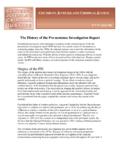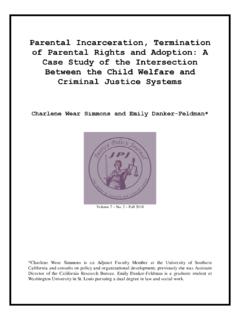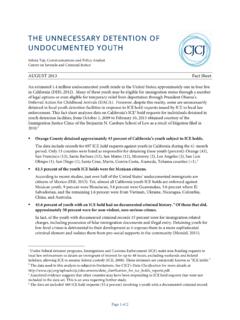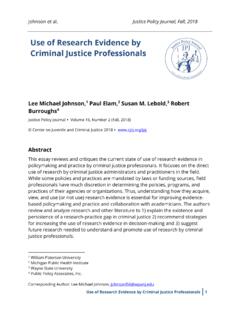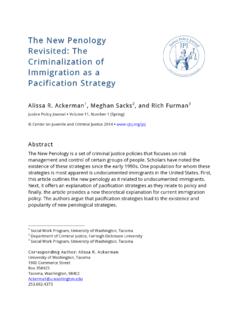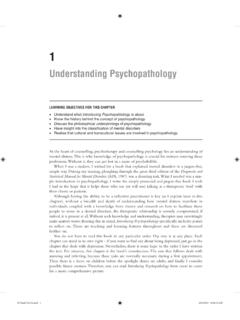Transcription of Assessing “Broken Windows”: A Brief Critique Randall G ...
1 CENTER ON JUVENI LE AND CRI MI NAL JUSTI CE. cj .org Assessing Broken Windows : A Brief Critique Randall G. Shelden Introduction: An Overview of Broken Windows Theory The early 1990s in New York City greeted William Bratton as the new commissioner of the New York Police Department. Bratton centered his attention on the New York subways, and reinvigorated the subway police. He was able to acquire new equipment and weapons for officers working below the streets. In an all out war against fare evasion and the homeless people who live in the New York subway tunnels, he authorized sweeps of the subway trains and eventually claimed that the subway had been recaptured for citizens.
2 His justification for such action stemmed from the broken windows theory which posits that more serious crimes evolve from minor infractions. They stated the theory as follows: If the first broken window in a building is not repaired, the people who like breaking windows will assume that no one cares about the building and more windows will be broken. Soon the building will have no windows. (Wilson and Kelling, 1982). Crime flourished because of lax law enforcement, the classic deterrence argument. Among other assertions, they contended that if rude remarks by loitering youth were left unchallenged, such youth will be under the impression that no one cares and their behavior will likely escalate to more serious crimes.
3 In other words, take minor problems and nip them in the bud before things get worse. Who knows, maybe the rude teenager of today will be the superpredator of tomorrow. This view 1. ignores the fact that millions of teenagers engage in all sorts of $rude# and other obnoxious behavior in front of adults yet never become career criminals. One result of such a view is the infamous policy known as zero tolerance, although supporters of this view have denied that broken windows is the same as zero tolerance (Kelling and Sousa, 2001). However, some do assert that they are the same, including some inside New York's police department, such as the NYPD Captain who stated that, I think we've gone overboard with zero tolerance.
4 Cops are being held to unrealistic expectations to arrest people, and the result is that the community now sees us as occupiers, not problem solvers (Wynn, 2001:107, emphasis added). Note the emphasis on the word occupiers, for this describes one of the major historical roles of the police in class societies (Shelden, 2001). Mayor Rudolph Giuliani came to power in New York City also during the 1990s. The Giuliani-Bratton team moved the war on crime from the subways to the streets, instituting a policy of broken windows. War had been declared on window washers (those unemployed individuals who washed windshields at city intersections the so-called squeegee men ), prostitutes, truant children (many who were truant because they had problems coping with inner city school violence), and homeless people living under bridges.
5 The people of New York rejoiced. After all, it is unsettling to be employed and be required to contend with, or see, the dangerous population of homeless and unemployed people on a daily basis in the streets%it give capitalism a bad name (Parenti, 1999;. Duneier, 1999). One police Captain, who worked in the Times Square area, recalled Bratton telling police officers, You're not just hanging out. Go find someone doin' something. Such as feel free to arrest someone for drinking a beer on the street? this officer asked. It was more like, you better arrest somebody for drinking in public (Wynn, 2001: 111).
6 This may be a slight exaggeration by this police Captain for, as will be noted later, police officers still had plenty of discretion and only 2. arrested or gave a summons to those who drank in public where there were a lot of people ( , an entertainment area), but for those who were drinking outside their apartment, for example, the police merely told them to go indoors (Kelling and Sousa, 2001). The trouble with broken windows theory is that it is really no theory per se, for we have to ask the simple question: what is the theoretical basis for it? In other words, what is the rational for claiming that if we start arresting minor offenders like window washers, then serious crime will go down?
7 Another important question: Why are windows in poor communities broken in the first place? Another reasonable question would be: How many broken windows have been repaired since the policy was instituted? The broken windows theory seems to be saying that the primary causes of crime are broken windows, or window washers, or homeless people sleeping in subways, etc. More specifically, the contention is that these minor disorders may lead to more serious kinds of crimes. Also, there is the assumption that those who engage in graffiti tagging, jumping turnstiles in the subways, or kids just hanging out are either criminals or future criminals.
8 In short, it reduces the city' s quality of life and creates a culture that encourages more serious crime (Erzen, 2001: 19). How is disorder defined? It is behavior that violates widely accepted standards and norms of behavior, and about which a broad consensus exists, in spite of racial, ethnic and class differences (Kelling and Coles, 1996: 4, emphasis added). Criminologist Wesley Skogan gets more specific, distinguishing between social disorder and physical disorder. The former includes specific behaviors like catcalling, drinking, prostitution, sexual harassment, while the latter include things like ill-kept buildings, trash, alleys with rats in them.
9 Disorder is also distinguishable from more serious crimes like rape and murder by such minor offenses like vandalism, public urination, unsolicited washing of windows, and aggressive panhandling (Erzen, 2001: 21). 3. Some of these claims seem absurd and perhaps should not even be taken seriously. But we must take it seriously, as it has been embraced by law and order politicians and police chiefs all over the Now Bratton has taken his approach to Los Angeles, where he hopes to stem the tide of a recent increase in violence. One may seriously question the claims about a broad consensus on disorder, both social and physical.
10 Including catcalling and drinking seem curious, as many of all ages engage in such behaviors (construction workers whistling at passing women, college students getting drunk and disorderly on fraternity or sorority row or during spring break). As for prostitution, apparently supporters of the broken windows theory are complaining about street hookers, rather than more expensive call girls (in Las Vegas the distinction between these two are quite dramatic, for we have available for high rollers very expensive women, including those who advertise in both the Yellow Pages and in alternative newspapers as escorts ).
